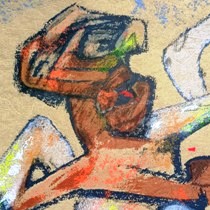Roberto Sebastian Matta
Roberto Sebastian Matta was born in Santiago de Chile in 1911. Matta was the great protagonist of late Surrealism, with his work not only paving the way for American Abstract Expressionism, but exerting and continuing to exert an important influence on contemporary artists.
After graduating in architecture from the Universidad Católica in Santiago in 1934 he moved to Paris to work in Le Corbusier’s studio and during a trip to Madrid he met Federico Garcìa Lorca, who put him in contact with Salvador Dalì and André Breton, who in 1938 invited him to participate in the Exposition International du Surréalisme, marking his baptism within the movement.
At the beginning of 1939 he moved to New York where he exhibited at the Julien Levy Gallery, the Pierre Matisse Gallery and Peggy Guggenheim’s famous “Art of this Century”.
His charismatic figure attracted the attention of a group of young people called New York School, including Jackson Pollock, Mark Rothko, Arshile Gorky and Willem de Kooning.
And it was by taking the automatic gesture characteristic of Matta’s work to the extreme that this group created a language that broke with European tradition, founding the first American movement: Abstract Expressionism. He moved to Rome in 1949 where he came into contact with Afro, Capogrossi, Burri, Leoncillo, Corpora, Turcato and Dorazio, while in Milan he had the opportunity to frequent the Spatialists, led by Lucio Fontana.
A storyteller through images, his visionary iconography oscillates between primitive cultures and the future, science and myth, history and news.
During the second half of the 20th century, Matta held exhibitions all over the world. In addition to the important retrospective at the MoMa in 1957, the one at the Centre Pompidou in Paris in 1985 is also worth mentioning.
His works are held in important museum collections, including the Solomon R. Guggenheim and MoMa in New York, Tate London and the Centre Pompidou in Paris. He died in 2002.
Contact us
info@niccoligallery.com

